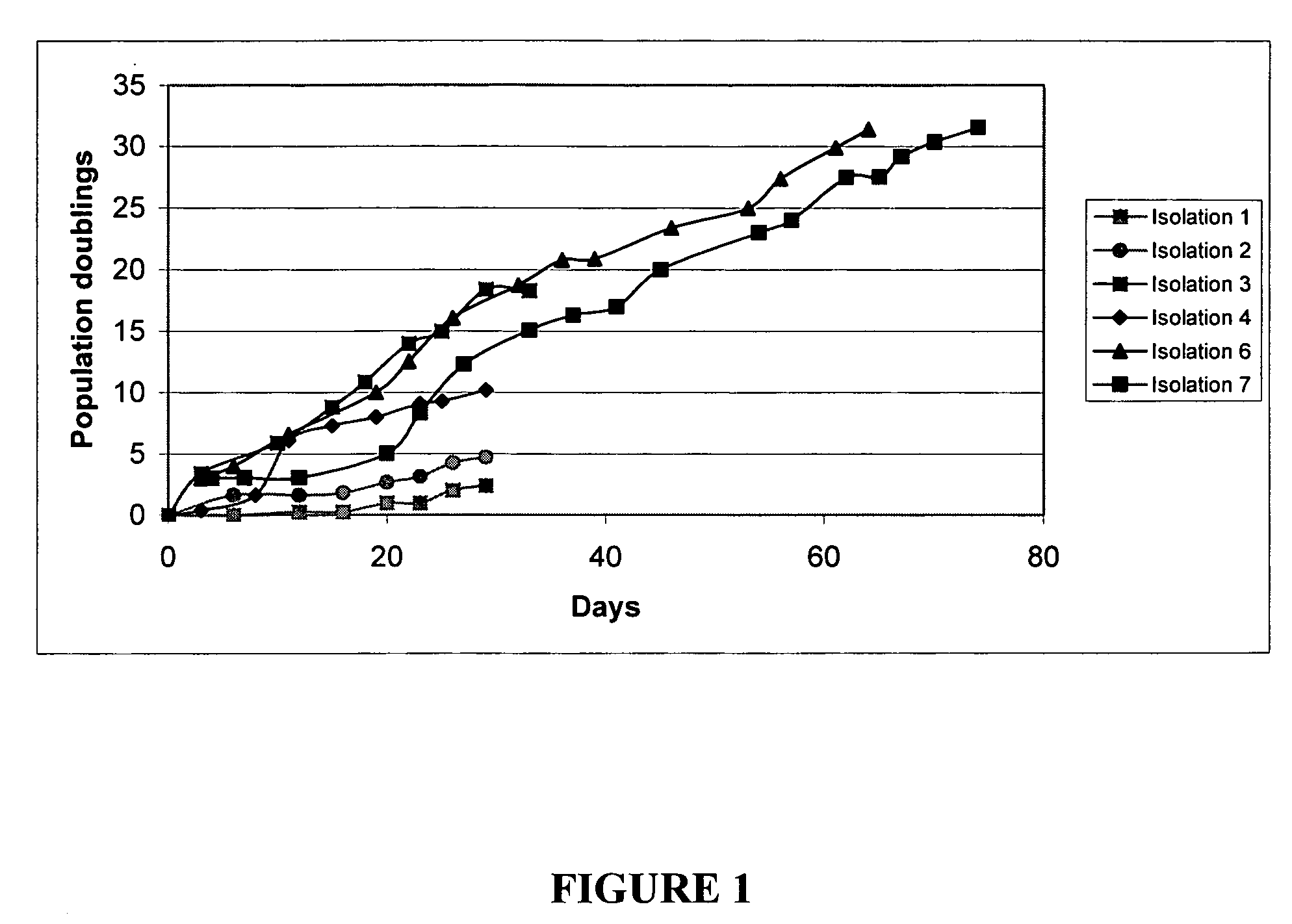Postpartum cells derived from umbilical cord tissue, and methods of making and using the same
a postpartum cell and umbilical cord technology, applied in the field of mammals, can solve the problems of time-consuming and expensive pre-testing, method not distinguishing the desired cells, and variation in the composition of serum lot-to-lot,
- Summary
- Abstract
- Description
- Claims
- Application Information
AI Technical Summary
Benefits of technology
Problems solved by technology
Method used
Image
Examples
example 1
Isolation of Cells from Postpartum Umbilicus Tissues
[0203] Postpartum umbilicus tissues were obtained upon birth of either a full term or pre-term pregnancy. Cells were harvested from five separate donors of umbilicus tissue. Different methods of cell isolation were tested for their ability to yield cells with: 1) the potential to differentiate into cells with different phenotypes, a characteristic common to stem cells, or 2) the potential to provide critical trophic factors useful for other cells and tissues.
Methods & Materials
[0204] Umbilical cell isolation. Umbilical cords were obtained from National Disease Research Interchange (NDRI, Philadelphia, Pa.). The tissues were obtained following normal deliveries. The cell isolation protocols were performed aseptically in a laminar flow hood. To remove blood and debris, the cord was washed in phosphate buffered saline (PBS; Invitrogen, Carlsbad, Calif.) in the presence of penicillin at 100 Units / milliliter and streptomycin at 100 ...
example 2
Growth Characteristics of Umbilicus-Derived Cells
[0222] The cell expansion potential of umbilicus-derived cells was compared to other populations of isolated stem cells. The process of cell expansion to senescence is referred to as Hayflick's limit (Hayflick L. The longevity of cultured human cells. J. Am. Geriatr. Soc. 22(1):1-12, 1974; Hayflick L. The strategy of senescence. Gerontologist 14(1):37-45), 1974).
Materials and Methods
[0223] Gelatin-coating flasks. Tissue culture plastic flasks were coated by adding 20 milliliters 2% (w / v) gelatin (Type B: 225 Bloom; Sigma, St Louis, Mo.) to a T75 flask (Corning Inc., Corning, N.Y.) for 20 minutes at room temperature. After removing the gelatin solution, 10 milliliters phosphate-buffered saline (PBS) (Invitrogen, Carlsbad, Calif.) were added and then aspirated.
[0224] Comparison of expansion potential of umbilicus-derived cells with other cell populations. For comparison of growth expansion potential the following cell populations w...
example 3
Growth of Umbilicus-Derived Cells in Medium Containing D-Valine
[0241] It has been reported that medium containing D-valine instead of the normal L-valine isoform can be used to selectively inhibit the growth of fibroblast-like cells in culture (Hongpaisan, 2000; Sordillo et al., 1988). Experiments were performed to determine whether umbilicus-derived cells could grow in medium containing D-valine.
Methods & Materials
[0242] Umbilicus-derived cells (P5) and fibroblasts (P9) were seeded at 5,000 cells / cm2 in gelatin-coated T75 flasks (Corning, Corning, N.Y.). After 24 hours the medium was removed and the cells were washed with phosphate buffered saline (PBS) (Gibco, Carlsbad, Calif.) to remove residual medium. The medium was replaced with a modified Growth Medium (DMEM with D-valine (special order Gibco), 15% (v / v) dialyzed fetal bovine serum (Hyclone, Logan, Utah), 0.001% (v / v) betamercaptoethanol (Sigma), penicillin at 50 Units / milliliter and streptomycin at 50 milligrams / millilit...
PUM
| Property | Measurement | Unit |
|---|---|---|
| Temperature | aaaaa | aaaaa |
| Fraction | aaaaa | aaaaa |
| Fraction | aaaaa | aaaaa |
Abstract
Description
Claims
Application Information
 Login to View More
Login to View More - R&D
- Intellectual Property
- Life Sciences
- Materials
- Tech Scout
- Unparalleled Data Quality
- Higher Quality Content
- 60% Fewer Hallucinations
Browse by: Latest US Patents, China's latest patents, Technical Efficacy Thesaurus, Application Domain, Technology Topic, Popular Technical Reports.
© 2025 PatSnap. All rights reserved.Legal|Privacy policy|Modern Slavery Act Transparency Statement|Sitemap|About US| Contact US: help@patsnap.com

